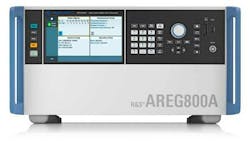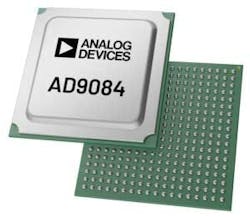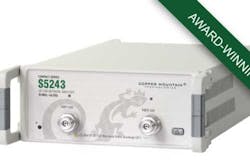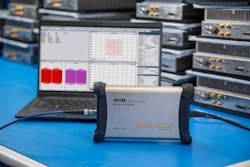Wireless Technologies Boost Diverse Markets
Members can download this article in PDF format.
Wireless technology has supported billions of lives around the globe for several decades, typically in the form of cellular communications. But the reach of wireless is expanding far beyond cellular antenna towers, and the technology is growing rapidly in support of such major markets as aerospace and defense, automotive electronics, communications electronics, financial technology (fintech), healthcare/medical services, and industrial manufacturing and warehousing.
Adoption of wireless technology can be traced to how efficiently and effectively wireless-aided functions can be added to an application. It also depends on how well companies supplying hardware and software can realize those wireless functions in keeping with current trends within each market area.
As wireless integrators look to suppliers of wireless technologies for the most practical and timely solutions for their applications, those suppliers must develop innovative wireless products, and often methods to model and measure them, to fuel strong ongoing growth in the use of wireless equipment within many of these markets.
For many users, wireless technology begins each day with a cellular telephone on an advanced cellular network such as a 3G, 4G LTE, or 5G wireless network. But as the numbers of users on these networks rises to occupy more of their available frequency spectrum, the networks are running out of bandwidth.
Wireless 5G network operators have hoped that extension to higher frequencies in the millimeter-wave (mmWave) frequency range (24 GHz and higher) will add enough capacity for many new users. However, such dramatic increases in frequency coverage require installation and maintenance of higher-frequency 5G infrastructure equipment. The added bandwidth is being used by people and things, with growing numbers of Internet of Things (IoT) devices like sensors providing wireless access to data via the internet.
As wireless cellular networks expand their frequency ranges, they increase the need for higher-frequency test equipment. Growth of 5G networks and coverage requires essential test instruments such as oscilloscopes, signal generators, spectrum analyzers, and vector network analyzers (VNAs) with frequency ranges well into the mmWave frequency range.
GSMA, the global organization unifying the mobile communications ecosystem, recently projected (in a 52-page report) more than 6 billion mobile 5G subscribers worldwide by 2030. The report predicted many new 5G subscribers coming from India and Africa.
The benefit of 5G to the global economy is expected to be at least $950 billion in U.S. dollars (USD) by 2030. The business will come from smartphone users as well as many “things,” such as wireless IoT devices, connected to the internet by fixed-wireless-access (FWA) services.
5G Networks Enhance Comms for Multiple Industries
In addition to wireless communications for the masses, 5G networks bring critical communications functions to automated industrial manufacturing assembly lines with fixed and mobile robots. Users in the general population can also gain internet access through public Wi-Fi systems.
Furthermore, 5G wireless networks are satisfying growing demands from individuals and businesses for virtual private networks (VPNs). These private wireless networks provide broadband connectivity for their owners and can be used for wireless connectivity throughout a company and its properties, such as warehouses, while still offering access to 5G networks. In some cases, automated factories and warehouses may employ communications by means of refined versions of 5G systems known as Private Industrial 5G networks, which meet the rigid requirements of manufacturing facilities.
Growth of 5G wireless communications systems will also be spurred by military users. Armed forces plan to adopt 5G spectrum, especially in the mmWave range, to apply 5G networks for real-time communications of command-and-control data for aerospace and defense applications. The generous spectrum capacity of 5G networks will boost the traditional DC-to-18-GHz frequency range of military systems, such as electronic countermeasures (ECM), electronic warfare (EW), and radar.
Extension of 5G networks into the mmWave frequency range will serve a growing number of applications within the aerospace and defense market, including for unmanned devices such as IoT sensors and unmanned aerial vehicles (UAVs) performing intelligence, surveillance, and reconnaissance (ISR) duties. Wireless 5G networks will share available bandwidth among commercial, industrial, medical, and military users as wireless applications expand in each market. 5G networks will provide military users with wireless access to high-speed data for critical missions, such as targeting and reconnaissance data.
Military demands for mobility and portability continue to encourage long-term design efforts for reduced size, weight, and power (SWaP) in electronic systems. Strategies to create components and PCBs with increased functionality and smaller size have carried over into other markets and supported component-dense monolithic microwave integrated circuits (MMICs) and power-dense semiconductor substrates such as gallium nitride (GaN).
In general, the use of 5G networks and adoption of newer technologies such as robots and UAVs are part of a general trend in the modernization of all branches of the U.S. armed forces. Both unmanned ground vehicles (UGVs) and UAVs employ wireless connectivity for communications and control.
Tactical UAVs are typically equipped with weapons, radar, communications systems, and GPS receivers to aid in target location, while ISR drones carry high-resolution cameras and their wireless communications links with bandwidths suitable for video exchanges. In all cases, remote-controlled battlefield drones require some form of wireless links or networking as the armed forces seek to adopt the most advanced electronic technologies available, including broadband wireless communications at mmWave frequencies.
Increasing use of UAVs for commercial business will also result in greater wireless use within those systems as numbers of commercial drones grow steadily within the next decade. According to research firm Grand View Research, the global commercial drone market was estimated at U.S.$19.89 billion in 2022 and is expected to grow at a compound annual growth rate (CAGR) of 13.9% from 2023 to 2030, contributing to the use of wireless technology in airborne applications.
While military comms still largely depend on Earth-based infrastructure, a growing number of communications links will come from space as the U.S. Space Force increases the size of its constellation of low-Earth-orbit satellites (LEOs). Having recently absorbed the U.S. Space Development Agency (SDA), the Space Force is seeking to reinforce ground-based wireless functions such as communications and weather monitoring from orbiting satellites and will be adding to the numbers of LEOS.
At the same time, commercial wireless comms service providers will be growing their LEOs constellations in efforts to eliminate gaps in coverage in their 5G wireless networks, combining terrestrial and space-based infrastructure equipment.
Wireless Hits the Road
Increasing use of electronic components and systems in motor vehicles will continue to drive demand for practical semiconductor solutions for applications such as vehicle-to-vehicle (V2V) and advanced driver-assistance system (ADAS) equipment.
Whether for vehicles with traditional internal-combustion engines, electric vehicles (EVs), or hybrid electric vehicles (HEVs) with a combination of engine technologies, radar-based ADAS gear relies on safety-critical components. These devices must be cost-effective but also precise and reliable under a wide range of operating conditions. For many vehicle owners, ADAS is simplifying driving, adding such functions as emergency braking and lane monitoring, and will continue to advance toward more autonomous vehicles.
Safer ADAS vehicles and their mmWave radar systems rely heavily on accurate measurements. As a result, major instrument suppliers have been extending the frequency ranges of signal generators and analyzers, while some even developed specialized test system solutions for characterizing ADAS equipment.
As an example, Rohde & Schwarz recently introduced a radar test system (RTS) tailored to ADAS testing at mmWave frequencies. The R&S AREG800A automotive radar echo generator can perform single-sensor ADAS testing as well as 360° automotive radar testing from 76 to 81 GHz (Fig. 1). Consisting of an automotive signal echo generator and the R&S QAT100 antenna array, the system will help trim the time-to-market for many ADAS equipment suppliers and support the growing wireless automotive market.
According to research firm MarketsandMarkets, the 2022 U.S. market for ADAS electronic devices was $30.9 billion and is projected to grow to $65.1 billion by 2030 at a CAGR of 9.7%. About one-half of the worldwide automotive semiconductor market is served by five major suppliers: Infineon Technologies, NXP Semiconductors, Renesas Electronics, STMicroelectronics, and Texas Instruments.
Of course, as more vehicles on the road rely on ADAS safety systems and are linked by wireless interconnections, they become vulnerable to “hackers” capable of remotely controlling (and stealing) a vehicle by wireless transceivers. The growth of automotive wireless applications is elevating the need for automotive cybersecurity software and electronic security systems to ensure that a wirelessly equipped vehicle remains in its proper parking spot.
Sometimes lost within the fast-growing automotive electronics market is the rapidly growing market for wireless-charging equipment, not just for EV batteries but for battery-powered medical and wearable electronic devices, cell phones, tablets, and other portable electronic devices. Grand View Research values the 2022 global wireless-charging market size at U.S.$12.92 billion and projects it to grow at a CAGR of 13.4% from 2023 to 2030. The growth rate is strong because of the use of wireless charging across so many different apps, including for aerospace and defense, automotive, healthcare, and industrial equipment charging.
Applications new to wireless technology are adding to demand for frequency spectrum and wireless connectivity. On the medical side, for example, wireless communications links are being incorporated into all healthcare monitors, such as heart-rate and blood-pressure monitors, to ease a physician’s task of checking the status of patients within a hospital or a private practice.
Inclusion of a wireless connectivity scheme such as Bluetooth, Wi-Fi, or Zigbee within a healthcare monitor enables a doctor to monitor multiple patients while in motion throughout a facility, using a battery-powered laptop computer or tablet. Networking a patient’s data within a healthcare facility also allows for greater freedom of movement for the patient and ready access to the patient’s data for nurses and other medical professionals within a facility.
Proliferation of wireless technologies within the healthcare industry is supporting increasing home care and remote diagnostics of patients. That’s often made possible by a combination of wireless connectivity standards such as in-building Wi-Fi linked to a wireless cellular system such as 3G, 4G LTE, or 5G.
Trend Setters in Wireless Tech
Software-defined-radio (SDR) technology provides some degree of flexibility for applications facing harsh conditions, such as the radiation of space missions. Suppliers of modular SDR components, such as Trident Systems, make it easier and quicker to develop space-qualified SDR communications systems.
In wide-area networks (WANs), where network traffic is routed through the internet with the aid of cloud software, large amounts of data can be transferred between parties instantaneously. SDRs can facilitate that transfer. SDR systems include software-defined antennas (SDAs) typically implemented by densely integrated semiconductors, such as system-on-chip (SoC) devices, in which the equivalent functionality of a complete wireless system is housed within a surface-mount-technology (SMT) package.
As SDR and other radio architectures expand into different wireless markets and applications, opportunities emerge for innovative semiconductor technologies capable of supporting increased functionality in smaller-sized devices operating at lower power levels. One of the most impressive semiconductor technologies for present and future wireless systems is the approach employed by Analog Devices (ADI), in which what was once contained on several PCBs is now integrated within a single miniature package.
ADI’s AD9084 Apollo mixed-signal front-end (MxFE) monolithic IC (Fig. 2) provides flexible, wideband multichannel transmit and receive functions by means of four digital-to-analog converters (DACs) and four analog-to-digital converters (ADCs). But these are not just any ADCs and DACs—the 12-bit ADCs and 16-bit DACs operate at a maximum sample rate of 20 Gsamples/s.
The IC features low-loss, high-speed interconnections and supporting components such as filters and multiplexers as well as more complex components like a clock multiplier and on-chip digital signal processor (DSP). It’s housed within an 899-ball ball-grid-array (BGA) package measuring just 24 × 26 mm and capable of handling operating temperatures from −40 to +110°C. The device helps shrink the size of systems processing signals with wide instantaneous bandwidths, while consuming no more than 30 W. Versions are available for maximum transmit and receive RF bandwidths including Ku-band.
Material Matters
Advanced electronic materials are essential to support the growth of wireless technologies in all major markets, and novel ways of fashioning those materials will help enhance wireless performance. Three-dimensional (3D) printing, when starting with suitable substrate materials, can now produce circuit and device features with desirable characteristics at mmWave frequencies.
Printable dielectric materials such as Radix from Rogers Corp. speed the way to creating advanced 3D antenna systems for emerging wireless applications, even at mmWave frequencies. With a low dielectric constant (Dk) of 2.8 at 10 GHz in the z dimension (thickness) and loss or dissipation factor (Df) of typically 0.0046 in the z axis at 24 GHz, the dark blue resin can be quickly formed into a desired shape on a FLUX 3D printer from Fortify using the printer’s digital-light-processing (DLP) engine.
GaN is a semiconductor substrate material capable of high power density at high frequencies. It’s been the basis for such devices as high-electron-mobility transistors (HEMTs) for high-power microwave and mmWave power amplifiers. These solid-state amplifiers are steadily replacing more traditional large-signal technologies such as traveling wave tubes (TWTs) and traveling-wave-tube amplifiers (TWTAs) in commercial, industrial, and military markets.
In addition to large-scale wafer and device capabilities from BAE Systems, Qorvo offers extensive GaN materials and devices for commercial and aerospace and defense applications (Fig. 3).
For components that must handle higher power levels in limited space, low-temperature-cofired-ceramic (LTCC) materials support miniaturization without sacrificing reliability from heat at higher power levels. Using proprietary LTCC substrate materials, Mini-Circuits has developed high-frequency filters capable of handling 1 W or more power in miniature SMT packages.
For example, the model BFCQ-4302+ bandpass filter has a passband of 36.5 to 50.0 GHz, a lower stopband of 100 MHz to 27 GHz, and an upper stopband that extends to 70 GHz. With typical 2-dB passband insertion loss, it can channel signals of 1 W or more through a package that measures only 2.5 × 2.0 mm.
Put to the Test
Rapid adoption of 5G and other wireless technologies must be backed by suitable measurement capabilities and test equipment. Many of the major test instrument suppliers have already developed test signal sources and analyzers capable of operation into the mmWave frequency to support evaluation and maintenance of applications such as 5G and ADAS equipment.
With the spread of wireless equipment, greater numbers of test instruments will no doubt be needed. Companies such as Copper Mountain Technologies and Signal Hound are developing practical solutions that don’t sacrifice performance for cost.
The model S5243 two-port VNA from Copper Mountain Technologies is a compact module that connects to a computer via USB interface to form a VNA capable of measuring all four scattering (S) parameters from 10 MHz to 44 GHz (Fig. 4). It can perform power sweeps along with linear and logarithmic frequency sweeps across a dynamic range of 135 dB and works with Windows or Linux test software. The VNA is representative of a trend in high-frequency test equipment away from larger, “rack-and-stack” equipment enclosures to smaller modules that support mobile and portable testing in facilities as well as on the road.
Conclusion
Over the coming years, wireless radio waves can be expected to continue to fill frequency spectrum as electronic systems communicate through airwaves and space waves. The market areas detailed here should all experience strong expansion, with some markets, such as wireless medical equipment, undergoing significant growth over the next decade.
The increased reliance on wireless electronic interconnections for smaller, more lightweight electronic products will encourage the continuing development of highly integrated, miniature designs. This also challenge test-and-measurement suppliers to perform more advanced measurements at higher speeds in support of accelerated times to market and increasing product-line volumes.
About the Author
Jack Browne
Technical Contributor
Jack Browne, Technical Contributor, has worked in technical publishing for over 30 years. He managed the content and production of three technical journals while at the American Institute of Physics, including Medical Physics and the Journal of Vacuum Science & Technology. He has been a Publisher and Editor for Penton Media, started the firm’s Wireless Symposium & Exhibition trade show in 1993, and currently serves as Technical Contributor for that company's Microwaves & RF magazine. Browne, who holds a BS in Mathematics from City College of New York and BA degrees in English and Philosophy from Fordham University, is a member of the IEEE.





